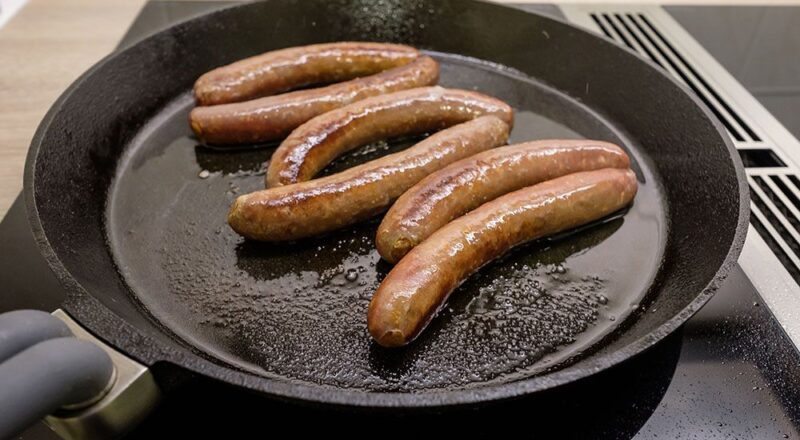Cooking with a cast iron skillet is a cherished practice among kitchen professionals and home chefs alike. However, when your cast iron skillet starts sticking after using it on an induction cooktop, it can sour your culinary experience. Understanding why this happens and how to resolve it can help maintain your skillet’s performance and extend its lifespan.

Understanding Induction Cooking
Induction cooking is a popular method that uses electromagnetic fields to heat cookware directly. Its efficient, heats quickly, and is easy to control. However, the unique heating method can sometimes lead to issues with cast iron skillets, such as sticking.
How Induction Works
Induction cooktops create a magnetic field that induces electrical currents in the cookware. This causes the cookware to heat up, cooking the food inside. For a cast iron skillet, this means the entire pan can heat evenly, but it can also mean that any imperfections in the seasoning or cooking method are highlighted.
Why Cast Iron Skillets Stick
Several factors can cause a cast iron skillet to stick, especially after induction use. These include poor seasoning, improper heating, and cooking techniques that do not complement the skillet’s characteristics.
Poor Seasoning
Seasoning is the process of creating a non-stick layer on the skillet’s surface. Without proper seasoning, food can easily stick, especially with the high heat of induction cooking. For tips on maintaining seasoning, consider reviewing resources such as Field Company’s guide on induction compatibility.
Improper Heating
Heating a cast iron skillet too quickly or unevenly on an induction cooktop can cause hotspots that lead to sticking. Understanding how to control the temperature is crucial. More insights can be found at cold spots in cast iron.
Cooking Techniques
Using the wrong oils, not allowing the skillet to preheat properly, or cooking foods that are too cold can all contribute to sticking. Its important to adapt cooking techniques to suit the skillet and induction method.
Preventing Sticking
To prevent your cast iron skillet from sticking, proper care and technique are essential. This includes maintaining seasoning, controlling heat, and choosing appropriate cooking methods.
Maintaining Seasoning
Regularly re-season your skillet by applying a thin layer of oil and baking it in the oven. This helps maintain a slick surface. For more detailed instructions, visit cast iron becoming smoky.
Controlling Heat
Gradually heat your skillet to allow for even temperature distribution. Avoid overheating by using lower settings and preheating the pan slowly.
Cooking Methods
Use oils with high smoke points and ensure that food is at room temperature before cooking. This minimizes the chances of sticking by allowing even cooking.
Maintaining Your Cast Iron Skillet
Proper maintenance of your cast iron skillet enhances its performance on induction cooktops. This involves regular cleaning, re-seasoning, and storing it properly.
Regular Cleaning
Clean your skillet with hot water and a brush. Avoid soap as it can strip the seasoning. Dry it thoroughly to prevent rust.
Re-Seasoning
After cleaning, apply a thin layer of oil and heat the skillet on your induction cooktop to maintain its seasoning.
Proper Storage
Store your skillet in a dry place to prevent moisture from affecting the seasoning. Placing a paper towel inside can absorb any excess moisture.
Common Myths About Cast Iron
There are many myths surrounding cast iron skillets that can lead to improper care. Understanding these myths can prevent mistakes.
Myth: Soap Ruins Cast Iron
While soap should be used sparingly, it isn’t the enemy. Occasionally cleaning with soap is fine if you re-season afterwards.
Myth: Cast Iron Heats Evenly
Cast iron retains heat well but heats unevenly. Preheat properly for even cooking, especially on induction cooktops. Learn more about uneven heating.
Myth: You Can’t Cook Acidic Foods
Cooking acidic foods occasionally wont harm your skillet if it’s well-seasoned. However, prolonged exposure can degrade the seasoning.
Conclusion
Understanding why your cast iron skillet sticks after induction use and how to prevent it involves a combination of proper seasoning, heat control, and cooking techniques. By following these guidelines, you can enjoy a non-stick cooking experience with your cast iron skillet.

FAQs
Why does my cast iron skillet stick after using it on induction?
Sticking can occur due to poor seasoning, rapid heating, or improper cooking techniques. Ensuring your skillet is well-seasoned and heated gradually can help.
How can I prevent my cast iron skillet from sticking?
Maintain a good seasoning layer, control the heat when cooking, and choose oils and foods that complement cast iron cooking methods.
Can I use soap on my cast iron skillet?
Occasional use of soap is acceptable if you re-season the skillet afterwards to maintain its non-stick properties.
This article contains affiliate links. We may earn a commission at no extra cost to you.

